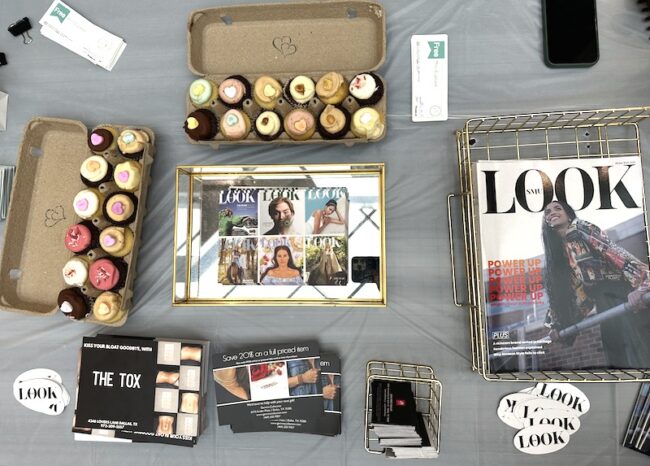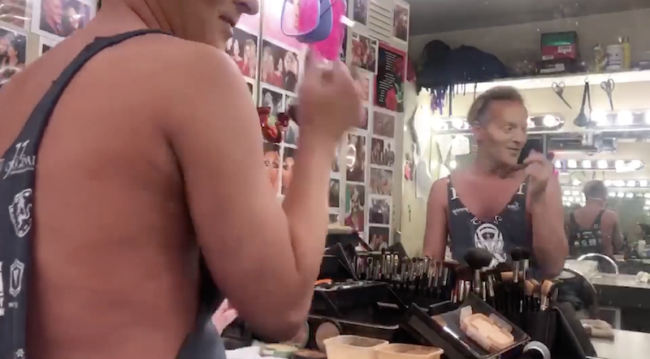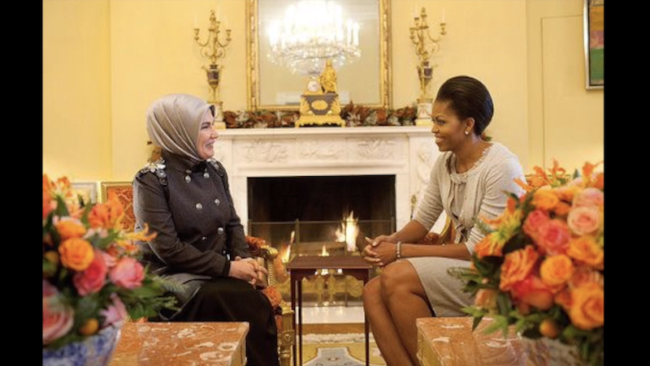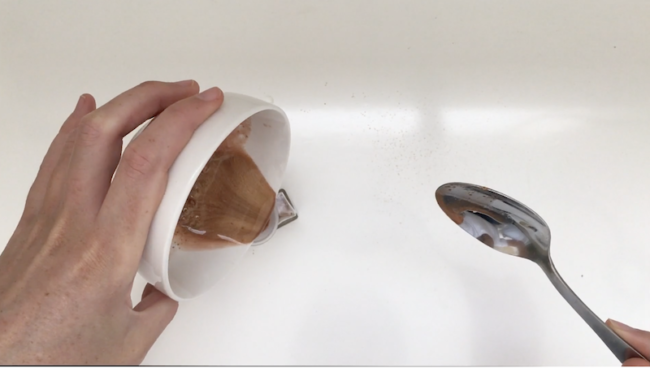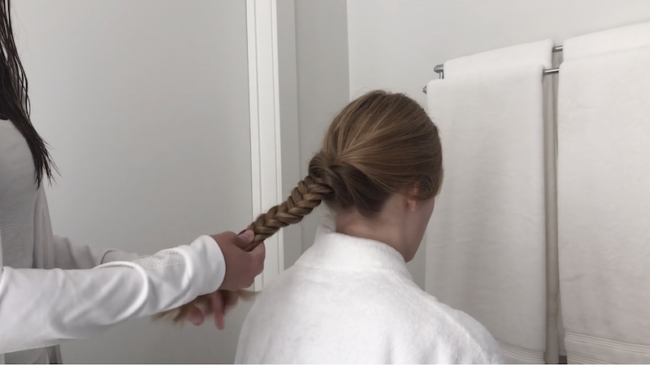By Diane Hogenkamp
Exhibit Information
Between the sandy palm fronds and tanned beach-goers in Naples, Fla., sits the Baker Museum. Known typically for its painting and photography exhibits, the Baker Museum switched things up when Frank Verpoorten, the museum director, accepted an offer to display a fashion exhibit. The Museum of the Fashion Institute of Technology’s exhibition, Yves Saint Laurent + Halston: Fashioning the ’70s, came to Naples.
“The exhibition has a scholarly framework, also naturally because it is a fashion exhibit, it is light-hearted,” Verpoorten said in an email interview. “The combination of the two appeals to our patrons.”

The exhibit, which was open from Nov. 17 until March 6, displayed a collection of creations by fashion designers Yves Saint Laurent and Roy Halston Frowick. Though having a fashion exhibit was a bit out of the ordinary for the Baker Museum, Verpoorten saw the parallels between this exhibit and others in the museum.
“If you look at what these two fashion designers represent, they were avant-garde designers. They did things no one else was doing, very much like great artists do,” he said in an interview with the Naples Daily News.
UNT Professor Myra Walker got more specific about how these designers were inspired by art and other designers in an email interview.
“Minimalism, color field painting with Halston,” she said. “And YSL: Mondrian, the LaLannes, his love of Schiaparelli.”
Cheri Fein is the executive director of public and media relations of the Museum at FIT. She said that this exhibit represented the best of both designers throughout their prime.
“This is the first exhibition to juxtapose their work and analyze the way they dealt with similar themes and aesthetics during the height of their careers,” she said in a press release.
Designers’ Backgrounds
Saint Laurent and Halston made lasting impressions with their creations and changed how fashion designers were perceived by society.
“Yves Saint Laurent had a huge impact on fashion over the course of his long career,” said Chelsea Bell, a fashion media professor at SMU, in an email interview. “From taking over the House of Dior at the age of 21 to creating the first tuxedo jacket for women to having an excellent pulse on what people on the street were looking for in fashion, YSL was often the liaison between what fashion was and where it was headed.”
Halston’s simplified styles and careful construction were just as innovative and desirable.
“He was creating beautifully simple gowns for the jet-set society crowd,” Bell said. “Things that could be folded up in a suitcase and pulled out for a glamorous evening at your destination.”
Themes of the Exhibit
Saint Laurent and Halston shared three fresh, unordinary themes within their 1970s designs: historicism, exoticism and menswear. These themes appeared throughout the exhibit’s collection of about 80 ensembles and 20 accessories. In placing the two designers’ works next to each other, the similarities between them are strikingly obvious.

From printed pajama sets to bold evening gowns, the designers shared many nearly identical silhouettes, fabrics and themes. These overlaps in design were especially evident in the pajama sets pictured above, two beige outfits featuring long capes, reddish-hued color-blocked evening wear and brightly colored caftans.
Both designers were mindful of the sleek and streamlined fit that was emerging in the 1970s, and that contributed to the similarity of their designs.
“One of their most significant stylistic influences was the Art Deco, or Art Moderne, revival,” said Patricia McClendon, assistant curator of costume at FIT.

At first sight, some of the designers’ work featured in the exhibit is almost too similar to tell apart. However, the two used different methods of construction. Halston made his garments using up-and-coming methods, eliminating heavy linings and rigid structure. Saint Laurent, on the other hand, constructed clothing with corset-like interiors and linings, alluding to techniques used in his early days designing for Christian Dior. Additionally, Saint Laurent’s pieces were often more opulent than Halston’s simpler designs.
“Saint Laurent is viewed as the great colorist who imbued his clothes with a sense of drama and fantasy, while Halston is seen as the era’s master of modernism and minimalism,” Fein said.
Saint Laurent and Halston used their preferred styles to put their own spin on feminized menswear, historically influenced designs and non-Western inspired clothing, all of which were displayed in the exhibit.
“Despite these opposing approaches, the two often arrived at similar incarnations of the exotic in the form of caftans and vibrantly colored pajama sets,” Fein said.

Designers’ Careers and Lasting Impact
Not only did the exhibit focus on the likeness of their fashion designs, but also on the equivalences in their career paths. These similarities are detailed on a timeline that spanned a wall of the exhibit.
“The two shared many career parallels, particularly their rises and falls, from the onset of their careers in the 1950s to their respective struggles in the 1980s, which were eerily in sync,” Fein said.
Both designers’ fame increased when their clothing appeared in magazines like Harper’s Bazaar and Time and on fashionable public figures including Lauren Bacall, Jacqueline Kennedy and Barbra Streisand.
“Being as famous as their clients was unheard of,” Patricia Mears, FIT deputy director, said in an interview with news-press.com. “They were superstars, and they still resonate today.”

In the 1970s, both Halston and Saint Laurent further moved away from couture and toward mass production with the introduction of their ready-to-wear lines. Many of their designs from the 1970s still influence designers today.
“I think everyone from Tom Ford to Gucci to Marc Jacobs all riff off of YSL,” said Kevin Willoughby, a former SMU fashion media professor. “In a sense, it’s a commercially safe thing to do since YSL already embedded these tropes into our popular-culture psyche.”
Saint Laurent, in particular, had a significant and lasting impact on menswear for women.
“It’s hard to look at any modern women’s suit and not cite Yves Saint Laurent as the inspiration,” Bell said. “When he created the first women’s tuxedo jacket and dinner suit, it was a completely groundbreaking concept that has become engrained as a fashion staple.”
Come the mid-1980s, Saint Laurent’s accomplishments were recognized with an exhibit of his clothing at the Metropolitan Museum of Art, despite receiving some harsh critiques around the same time. A year later, Halston lost the right to design under his own name after a failed collaboration with JC Penney.
By following the designers’ ups and downs, Saint Laurent + Halston: Fashioning the ’70s opens viewers’ eyes to how influential these designers were and how they paved the way for modern-day fashion.
As Mears said, “It was the real blooming of the counterculture. All the rules of fashion got thrown out, and also the hierarchy of fashion that we think of.”



